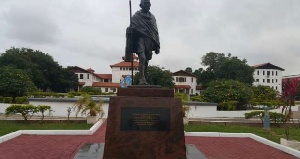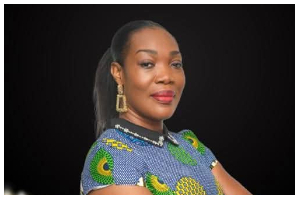By Nana Yaw Osei
The erection of Indian iconic freedom fighter and thinker, Mahatma Gandhi’s statue on the campus of University Ghana (UG) was encumbered with a controversy. For example, a former Director of the Institute of African Studies, Professor Akosua Adomako Ampofo, started a campaign for the removal of the statue of Mahatma Ghandi from the UG campus on the grounds that the Indian philosopher was racist.
I read with stark horror and amazement from Ghanaweb.com on October 4, 2016 that Gandhi’s portrait at UG campus had been defaced. This is very unfortunate because Gandhi himself reportedly said: “Be the change that you wish to see in the world.” The main subject of contention here, is racism.
The purpose of this article is to reflect on the action of some staff and students of UG against the mounting of Gandhi’s statue within the pale of a philosophical theory known as prisoner’s dilemma.
The prisoner’s dilemma is a sort of game theory, a discipline in mathematics that looks at various outcomes from situations that require strategy. This is notwithstanding the fact that prisoner’s dilemma goes beyond simply being a mathematical intuition. It poses significant questions about ethics, psychology and philosophy. It is applicable to the real world situations like the destruction of Gandhi’s statue on the grounds of racism.
In 1950, RAND Company employed mathematicians Merrill Flood and Melvin Dresher as part of their ongoing research into game theory and how it could be applied to global nuclear strategy. Relying on the puzzle that Flood and Dresher created, Albert Tucker, a professor of Princeton University, New Jersey, made their work more accessible to the public by creating a theory known as prisoner’s dilemma.
The theory asserts for example that two prisoners, Prisoner Yaw and Prisoner Adu are taken into custody. The police do not have a sufficient amount of evidence, so they decide to keep Yaw and Adu in separate rooms. The police officers tell each prisoner that if he turns in the other person and the other person remains silent, he will be able to go free whereas the prisoner who remains silent will face a time in jail.
If both Yaw and Adu confess, they will both have to face some jail time but a shorter sentence than the one faced by the person who did not speak (Remember! Adu will never be silent if Yaw speaks because he alone will be jailed). If both prisoners Yaw and Adu remain silent, they will both face an even shorter prison sentence.
The dilemma in the theory is this: Prisoner Yaw and Prisoner Adu are better off confessing, but the outcome from having them both confess is much worse than it would have been if both had remained silent. The prisoner’s dilemma is a perfect illustration of the misunderstanding that arises between group rationality and individual rationality. If a group of people act rationally, they will actually do far worse than if a group people act irrationally.
In the prisoner’s dilemma, it is assumed that all players are rational and know that the other player involved is rational. The rational thought would be to defect. However, by deciding to protect themselves and acting in their own interest, the prisoners will actually be worse off.
Gandhi who happens to be a ghost and the UG community are the prisoners here. By choosing to protect themselves and acting in their own interest, both UG community and Gandhi (if he is not dead) will actually be worse off when it comes to racism. Thus, the decision to deface the dummy of Mahatma Gandhi especially when he is a ghost does not align well with my intuition. Are some UG students and professors telling us not to forgive in this world? This is an intellectual dishonesty.
Colonization and slave trade is considered the most egregious holocaust bequeathed to Africans. In his book: “Christopher Columbus and the Afrikan Holocaust, Slavery and the Rise of European Capitalism” page, 93, Professor John Henrik Clarke, asserted that slavery and colonization remained the world’s greatest holocaust. “It is our holocaust because this is a holocaust that started 500 years ago and it is not over. We do not start our count at 6 million, we start counting at 60 million, and we have just begun to count.” Professor Clarke, intimated.
There are many professors in Ghana who used taxpayers’ money under the pretext of scholarship and went to Europe to pursue PhD in African studies. Must they go to Europe to study Africa or Ghana? How many of them came out to say that because of colonization, slave trade and racism they would not go? Ghana and India have a very good diplomatic relations.
The two countries are both members of Commonwealth of Nations. Many Ghanaian students are studying in India. Indian government supported the construction of Ghana’s presidential palace under President Kofour’s administration. The destruction of Gandhi’s statue will ignite a covert diplomatic tension.
UG is an international university and should have raised the bar of prestige when it comes to such conducts. Kwame Nkrumah of Ghana had his flaws, yet at Makerere University in Uganda, one of their halls of residence was named after Nkrumah.
Also, even in the Republic of South Africa where people are discrediting Gandhi on their behalf, some of their freedom fighters such as Nelson Mandela, Walter Sisulu, and Oliver Thambo had their inspiration from Gandhi (Source: “Long walk to freedom, The Autobiography of Nelson Mandela” page 369). The destruction of Gandhi’s statue is very unfortunate.
Like prisoner’s dilemma analogy, the decision to deface Gandhi’s effigy makes both UG community and the ghost Gandhi worse off when it comes to racism. We must also take into accounts individuals’ culture, traditions and values before tagging them as racist. Oh! Fellow countrymen, love is stronger than hate. “I know that I am intelligent because I know that I know nothing.” (Socrates).
Nana Yaw Osei (Padigo) is a PhD Candidate in Psychology, Arizona, USA. Writer's e-mail: padigogoma77@yahoo.co.uk
Opinions of Thursday, 6 October 2016
Columnist: Osei, Nana Yaw















